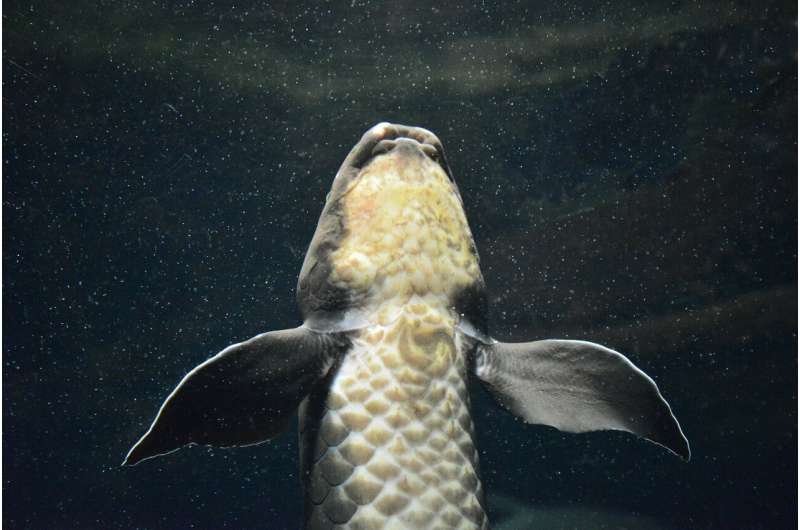What the lungfishes' genome teaches us about the vertebrates' conquest of land

Using cutting-edge DNA sequencing technologies, a group of laboratories in Konstanz, Würzburg, Hamburg and Vienna, led by evolutionary biologist Professor Axel Meyer from the University of Konstanz, have fully sequenced the genome of the Australian lungfish. The genome, with a total size of more than 43 billion DNA building blocks, is nearly 14 times larger than that of humans and the largest animal genome sequenced to date. Its analysis provides valuable insights into the genetic and developmental evolutionary innovations that made it possible for fish to colonize land. The findings, published online in the journal Nature, expand our understanding of this major evolutionary transition in the Devonian ~420 million years ago.
Lungfishes are the closest living fish relatives of humans. They still have a lot in common with fish, but have evolved some characteristics of terrestrial vertebrates. Discovered exactly 150 years ago, the Australian lungfish (Neoceratodus forsteri) is considered a "living fossil" that closely resembles fossils of lungfishes (Ceratodus) that lived until 100 million years ago. The anatomical bone arrangement of their "fleshy" fins is recognizably similar to that of tetrapods, including human limbs, and the Australian lungfish also moves more like a salamander than a fish. As their name implies, lungfish take oxygen via lungs that they use to breathe air at the water's surface.
The evolutionary history of lungfishes is extremely long. They belong to the few surviving lobe-finned fish lineages (Sarcopterygii) that lived at the time of the "conquest of the land" about 420 million years ago, and of which many have long since become extinct. One of this extinct lines of lobe-finned fish gave rise to terrestrial vertebrates, the tetrapods, that is, all amphibians, reptiles, birds and mammals. Lungfish still resemble these extinct lineages of that time, which successfully left the water. This is why studying their genome is so important and promising. The lungfish genome, however, is among the largest of all animals. It is nearly 14 times larger than that of humans, which previously made it impossible to sequence. Using cutting-edge DNA sequencing technologies, the research consortium has fully sequenced and assembled the giant genome of the Australian lungfish. It is the largest animal genome sequenced to date.
The complete sequencing of the Australian lungfish genome, with a total size of about 43 billion DNA nucleotides, now makes it possible to confirm the key evolutionary position of lungfishes as the closest living relatives of tetrapods. Additionally, the new and much larger data set of the decoded genome allows to confirm the earlier hypothesis that the lungfish is more closely related to terrestrial vertebrates than the coelacanth, which for more than 50 years after its discovery in 1938 was considered the closest living fish relative to humans.
Moving to land required a series of evolutionary innovations
"What can we find in the lungfishes' genome that explains how these fish could leave the water and move to land?" says Axel Meyer. Genomic pre-adaptations to the new environmental conditions of terrestrial life have been found in the genomic analysis. The major evolutionary event of colonizing the land required a number of other evolutionary innovations in addition to the development of the lung, such as the abilities to smell scents in the air and to move on land. Based on genome sequencing, the study reconstructs land conquest from several aspects such as the evolution of limbs from fins, air breathing, olfaction and reproduction. Thus, it was shown that the same genes that control embryonic lung development in humans also fulfilled this function in the lungs of lungfish. "The lungs of lungfish can therefore evolutionarily be traced to the same origin as those of terrestrial vertebrates, including humans," says Meyer.
The gene families that confer olfactory sensing have significantly grown, and the development of fins is comparable to the embryology of human hands in many aspects, such as the function of the hox-c13 and sal1 genes. The architecture of the fingers in the hand and also of the ulna and radius is already laid out in the fin of the lungfish, for which the same genes and the same gene regulation are responsible as in humans.
The "signature" of the common evolutionary origin preserved
Even in the face of the immense size of the genome, the arrangement of genes on the chromosomes is surprisingly conservative in evolutionary terms, making it possible to reconstruct the state of the primordial "Ur-vertebrate" chromosome set. Thus, despite the unique expansion history of the lungfish genome, the genetic organization and homology, the "signature" of the common evolutionary origin, i.e. of the chromosomes, has been preserved for hundreds of millions of years.
Several individual lungfish chromosomes are each as large as the complete human genome (with 23 chromosomes) combined. The enormous size of the lungfish genome can be explained by mobile DNA elements of different classes, whose position in the genome is variable and which together account for 90% of the total genetic material. The so-called LINE elements that belong to this group have been duplicated extremely frequently in two waves during the evolutionary history of lungfishes. In the composition of these mobile elements, too, the lungfish already resembles terrestrial vertebrates more than fish.
More information: Axel Meyer et al. Giant lungfish genome elucidates the conquest of land by vertebrates, Nature (2021). DOI: 10.1038/s41586-021-03198-8
Journal information: Nature
Provided by University of Konstanz



















